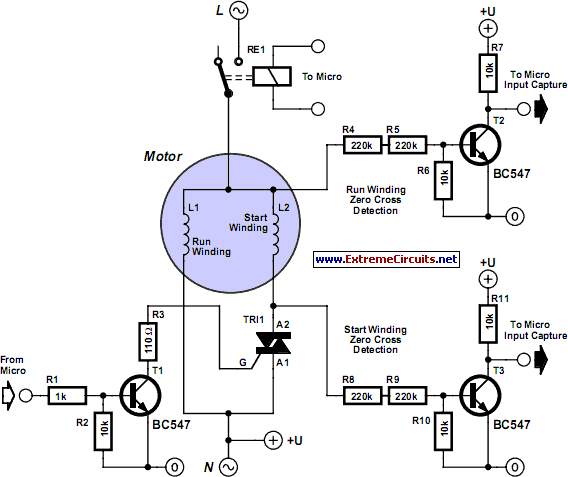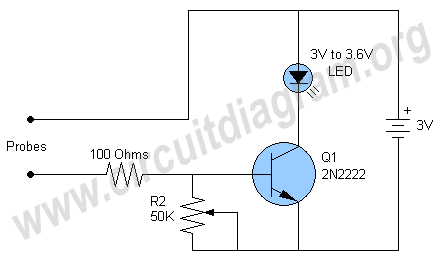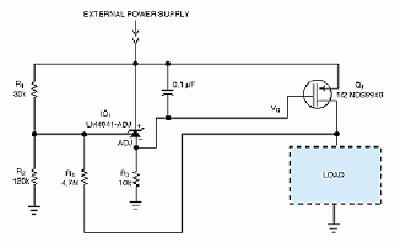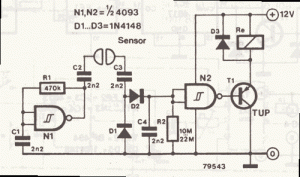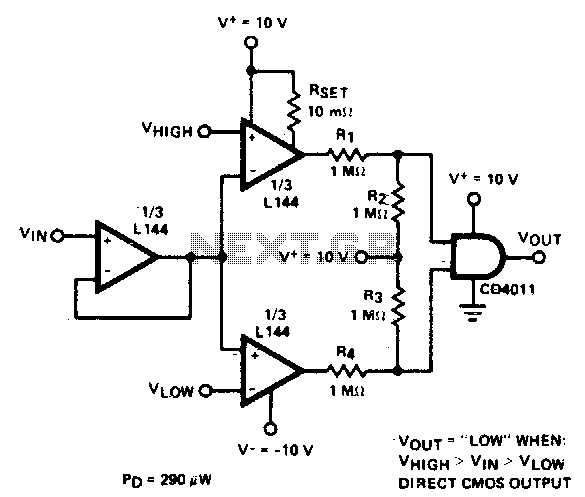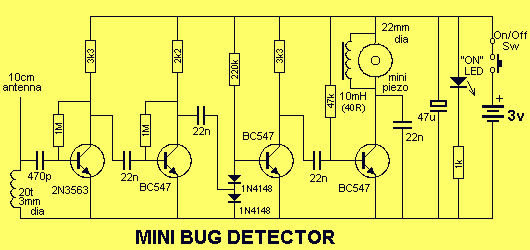
Moisture Detector
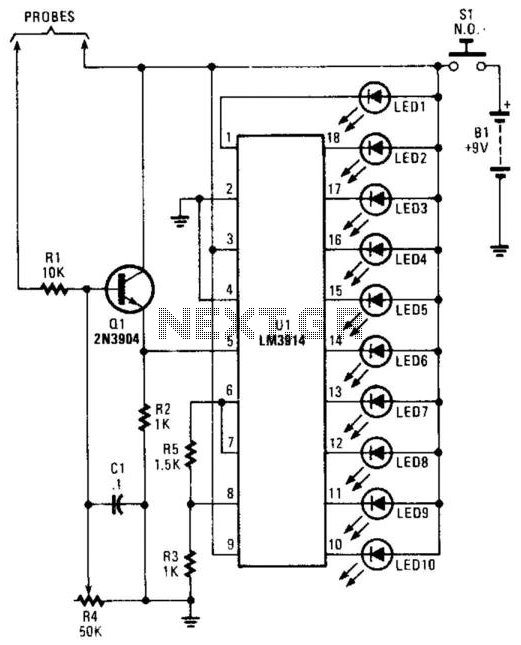
A bar-graph LED driver is utilized to control 10 LEDs, providing a relative indication of moisture levels. The moisture probes are connected in such a way that the electrical conductivity resulting from moisture tends to forward bias transistor Q1, generating a DC voltage at pin 5 of integrated circuit U1 that is proportional to the leakage current. Ideally, the probes should be constructed from stainless steel.
The bar-graph LED driver circuit is designed to visually represent moisture levels through the illumination of ten individual LEDs arranged in a linear configuration. Each LED corresponds to a specific range of moisture levels, allowing for an intuitive understanding of the moisture content in the environment.
In this circuit, moisture probes act as sensors, detecting the presence of moisture based on their electrical conductivity. When moisture is present, it decreases the resistance between the probes, allowing a small leakage current to flow. This current forward biases transistor Q1, which is an essential component of the circuit. The forward biasing of Q1 allows current to pass through, influencing the voltage levels at pin 5 of the operational amplifier or microcontroller (U1). The voltage at this pin is directly proportional to the amount of leakage current, thus providing a measurable output that correlates with moisture levels.
For optimal performance, the moisture probes should be made of stainless steel due to its corrosion resistance and durability in moist environments. This material choice enhances the longevity of the probes and ensures accurate readings over time.
The overall design may include additional components such as resistors and capacitors to condition the signals and stabilize the operation of the LED driver. The bar-graph display can be designed to light up sequentially, with more LEDs illuminating as moisture levels increase, providing a clear visual representation of the current moisture status. This functionality is particularly useful in applications such as soil moisture monitoring, industrial processes, and environmental sensing.
In summary, the bar-graph LED driver circuit effectively utilizes moisture probes and a transistor to provide a clear visual indication of moisture levels, with stainless steel probes ensuring durability and reliable performance. A bar-graph LED driver is used to drive 10 LEDs to give a relative indication of moisture. The moisture probes are connec ted so that electrical conductivity due to moisture tends to forward bias Ql, providing a dc voltage at pin 5 of Ul that is proportional to leakage current. Ideally, the probes should be made of stainless steel. 🔗 External reference
The bar-graph LED driver circuit is designed to visually represent moisture levels through the illumination of ten individual LEDs arranged in a linear configuration. Each LED corresponds to a specific range of moisture levels, allowing for an intuitive understanding of the moisture content in the environment.
In this circuit, moisture probes act as sensors, detecting the presence of moisture based on their electrical conductivity. When moisture is present, it decreases the resistance between the probes, allowing a small leakage current to flow. This current forward biases transistor Q1, which is an essential component of the circuit. The forward biasing of Q1 allows current to pass through, influencing the voltage levels at pin 5 of the operational amplifier or microcontroller (U1). The voltage at this pin is directly proportional to the amount of leakage current, thus providing a measurable output that correlates with moisture levels.
For optimal performance, the moisture probes should be made of stainless steel due to its corrosion resistance and durability in moist environments. This material choice enhances the longevity of the probes and ensures accurate readings over time.
The overall design may include additional components such as resistors and capacitors to condition the signals and stabilize the operation of the LED driver. The bar-graph display can be designed to light up sequentially, with more LEDs illuminating as moisture levels increase, providing a clear visual representation of the current moisture status. This functionality is particularly useful in applications such as soil moisture monitoring, industrial processes, and environmental sensing.
In summary, the bar-graph LED driver circuit effectively utilizes moisture probes and a transistor to provide a clear visual indication of moisture levels, with stainless steel probes ensuring durability and reliable performance. A bar-graph LED driver is used to drive 10 LEDs to give a relative indication of moisture. The moisture probes are connec ted so that electrical conductivity due to moisture tends to forward bias Ql, providing a dc voltage at pin 5 of Ul that is proportional to leakage current. Ideally, the probes should be made of stainless steel. 🔗 External reference
